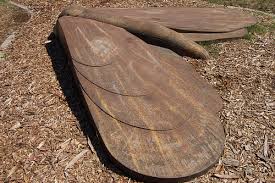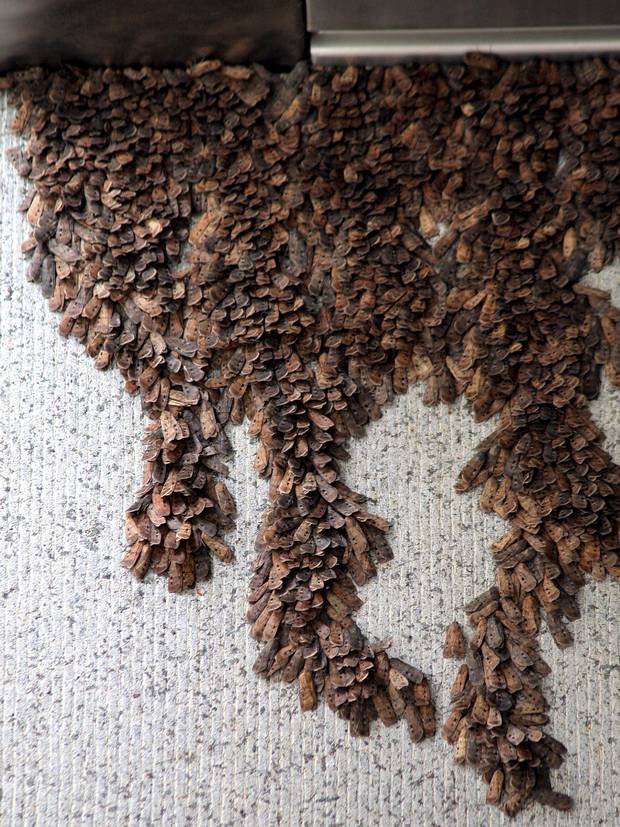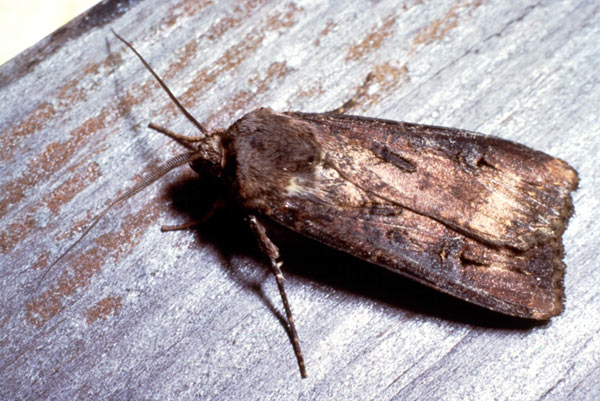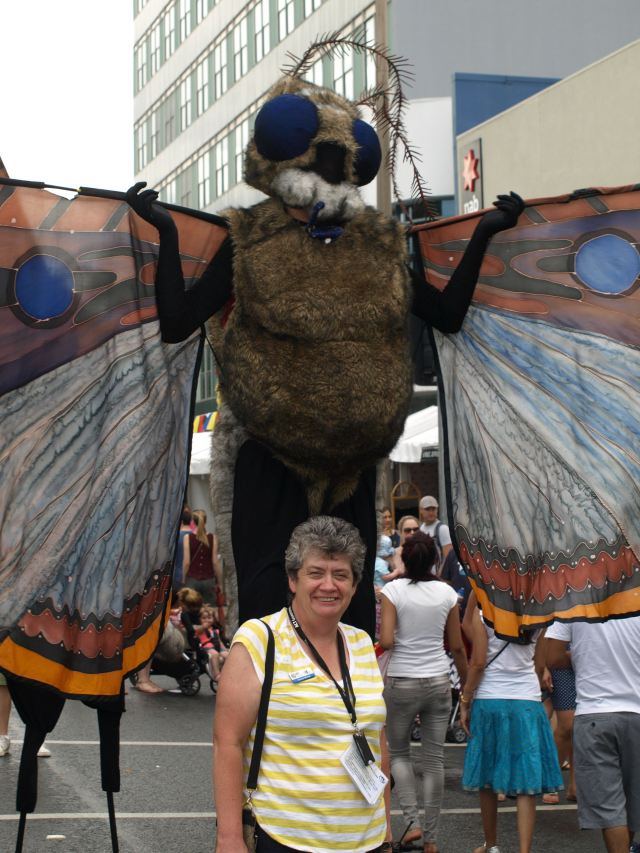Lisa, from the UK, who reads my posts and runs bite size memoir each week commented that she would like to see the moth that caused me to douse my room with napthalene flakes. Hence this post was born.
The Bogong moth is so memorable in Australia that statues are built to honour it, people wear bogong moth outfits to fancy dress parties and the like and in the eastern states (mainly New South Wales and Queensland) you know that summer is around the corner when the bogong starts invading.

photo http://www.flickr.com
The moth is large with a wingspan of around 2 inches and is recognised by arrow shaped dark markings, a dot resembling a comma and another, lighter spot all of which are on its upper brown wings. It lays its eggs at the base of plants in New South Wales and Queensland and approximately four weeks later the caterpillar emerges. It hides in the ground during the day and feeds at night – decimating the plants it attacks. It is known to farmers as cutworms as they cut up the pieces of plant and take them to their homes in the ground to eat. They love to eat almost everything the farmer likes to plant including cereal crops, peas, cabbages and cauliflowers to name just a few.
When it is about two inches long it weaves itself a cocoon and in another four weeks the moth emerges. Being a temperate climate moth just before summer starts the moths start their migration to a cooler place – caves in the Australian alps. For many of these moths this migration covers a distance of 3,000 kilometres (1,865 miles). The Bogongs don’t like to travel alone and somehow they all start their journey together in numbers of ten to millions.
For cities in the flight path of these moths problems arise for both the city and the moths. As the moths fly at night the city lights fool them into thinking the sun is coming up and they will attempt to find a dark place to rest and in the type of numbers entire walls of buildings can be hidden by the moths covering its surface.

photo http://www.independent.co.uk
Page by kathy marks – Australia’s bogong moth invasion turns even yawning into a potential health hazard
Eventually they find the cool caves and settle for the Summer. The bogong was a staple food of the aboriginal people in the area and animals still make their way to the caves to feast on the moths. An aboriginal festival to celebrate with feasting on the moths traditionally attracted many people and is still held today – called the Ngan Girra Festival.
The moth is extremely nutritious with a body comprising 60% fat. At the end of summer the moth makes its way north to lay its eggs and start the cycle over again.
Bogong moths are not the largest moths in the world. This honour is taken by the Atlas moth, a relative of the silkworm, of South East Asia which has a wing span of over 10 inches. The Bogong by sheer numbers, in Australia, makes you feel as though it is one huge moth.
All photos are taken from the internet and attributed to the site from which they were taken.








cover your mouth when you yawn….
LikeLike
LOL
LikeLike
My first experience with them was while camping on the Murray River. Luckily they weren’t in huge droves but enough to force us to put out the light and go to bed. We get Emperor gum moths here in central Victoria, now and then.
LikeLike
I can believe that Christine. We have had to do that ourselves in the house. Shut the doors and turn the lights out. We know someone who designed their house for moths and other night fliers where the inside was lit from outside so the fliers all stayed outside. The Emperor Gum is a beautiful moth. I like the fake eyes on its wings.
LikeLike
Never thought to see a post about the bogong, Irene, and delighted to do so ! [grin]
LikeLike
They’re a way of life for us M-R. I don’t usually give them a thought.
LikeLike
They used to be here, too; but like so many other things affected by climate change, no more …
LikeLike
My young life was surrounded by Lepidoptera of all sorts. Dad bred them and we collected them. I remember waking to find an Atlas moth had hatched and it was sitting on a branch in the Archaeologist’s bedroom drying its wings. Dad would have loved this and it brought back so many memories. In fact I feel a post coming on…. Thank you so much for sharing. What a great post.
LikeLike
My childhood was confined to silkworm breeding but we were fascinated with the cycle that happened in the shoe box. If your Atlas moth was like the ones here it would have been very beautiful. Glad it brought back memories and look forward to your post. Lisa has started a chain post (much nicer than the old chain letter).
LikeLike
What a fabulous answer to my question Irene! We don’t really have plagues of anything here so it’s interesting to contemplate this happening with moths! And big ones too.
The ‘worse’ I’ve ever experienced with moths is having hummingbird hawk moths placed in my hair by a cat called Norah, we used to have. It was her favourite ‘gift’ in the middle of the night – a startling wakening though she often woke me up with her loud purrs before they were wrapped up too much to rescue! The hummingbird hawk both is probably only an inch and a half long but a fat and juicier looking one than these – I bet they’re nutritious too though I won’t be trying one anytime soon!
Thank you for this post – love it ! 💜 Lisa xx
LikeLike
PS I totally understand now why you doused your bedroom in naphthalene ! 😀
LikeLike
XD
LikeLike
🙂
LikeLike
I don’t think Norah would have been too popular had she been my cat.
I find it fascinating the wonderful experiences that people like Geoff and Noelle have had with moths. When I woke this morning I had no thought of moths, let alone a moth post but I love what recolllections it has brought for others.
Thanks for the prompt.
LikeLike
Moths were better than the worms she collected when it rained! Great thread this one! Xxx
LikeLike
Having used the larvae of a very large moth, Manduca sexta, the tobacco hornworm, for much of my research, this post was fascinating for me. Most insects, especially the larvae, are rich in fats. Manduca unfortunately contains cardiac glycosides, making it dangerous to eat, so most birds avoid it. But another species I used, Galleria mellonella, the wax worm, is actually quite delicious. I used to fry the larvae and serve to students working in my lab. They taste like bacon bits. The very tiny ones could be spread on crackers. I know this has an inherent yuck factor, but you take your protein and fat where you can, as did the aborigines, if you aren’t living in a society with grocery stores!
LikeLike
Noelle I love your story and the memories you have recounted. I bet your students have never forgotten their experiments with the Galleria Mellonella. It is a pleasant change to hear these strange foods being described as tasting of something other than chicken. Yes I learnt in Vanuatu that the luxury of being able to be picky with food changes quickly when you don’t have supermarkets.
LikeLike
Yikes, Irene, I thought slugs were bad enough as a pest in the garden! Luckily for us here our moths are always in such low numbers it’s a delight to come across them. Hope people are still eating those big beasts – free food is not to be sniffed at.
LikeLike
I don’t know Anne whether anyone is still eating them. I haven’t seen them on the menu at any restaurant I’ve been to. Though if you had seen Noelle’s comment above there could be some uni lecturer in Aus serving them up to her students. When we get the next invasion I might try frying them up.
LikeLike
Informative, but ewwww! I won’t be sprinkling any bogong moths on my salad any time soon – even if they are nutritious 🙂
LikeLike
I agree Joanne, they aren’t going on mine either 🙂
LikeLike
Last night I nearly hit my head on the porch dodging a single moth. I think I might do bodily harm trying to escape an entire flock of these things! But very interesting, both culturally and geographically.
LikeLike
You and Sherri both have an aversion to moths. I don’t know whether it is because there are so many other things which enter the house they don’t worry me. There is much worse… You would struggle badly when they come in droves.
LikeLike
This gave me the chills, I have an absolute aversion to moths of all kinds. The kids would have to rescue me at night when they would hear me screaming if one came into my bedroom, I would be too scared to move. The fluttering around my head, their furry bodies, everything, I’ve got goose bumps just looking at these photos! They are huge…no wonder you sprayed your room like that, I would have done the same! As for eating them, I honestly don’t think I could do it..but if I were starving? No…just the thought of it…
Very informative post though Irene, Lisa must be thrilled 🙂
LikeLike
I don’t think I would eat them either but if starving I might just do so but you would have to make sure that it was the right kind of moth because as Noelle pointed out some can be quite damaging to your health. XD
LikeLike
Pingback: A rustle in the bedroom | TanGental